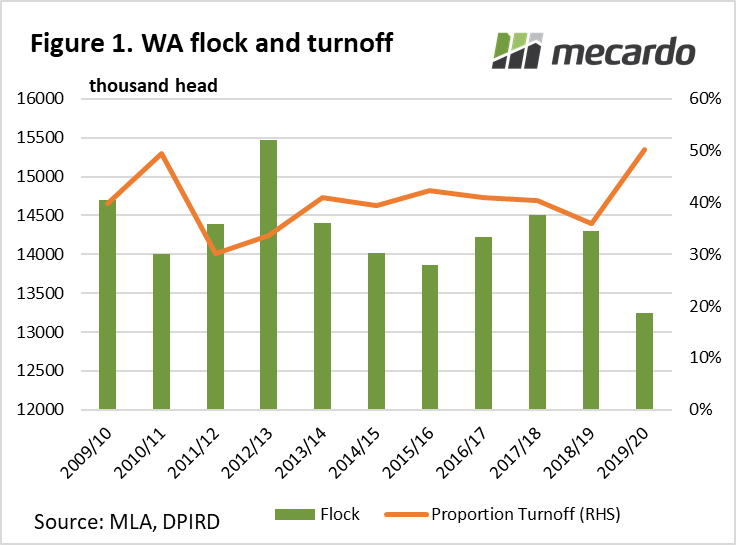It’s often said that Western Australia is like its own country. In terms of Sheep markets the West and East coast divide is just as prominent, with different market drivers, flock structures and capacity constraints existing. This diversity offers some protection to the Australian flock, but with a new low WA flock reported this year, is undersupply a threat to the West?
This season has been a prime example of the diversity in sheep production, with poor seasonal conditions in Western Australia and high turnoff, being met with increased demand from eastern buyers as favourable seasonal conditions encourage rebuilding.
50% of the WA flock in 2019/20 was turned-off, which includes slaughter, live exports and interstate transfers (Figure 1). The last time turn-off as a percentage of the flock was at close to this level was in 2010/11. Back then, the WA flock was at an estimated 14 million and once the season turned favourable, supply got very tight. Fast-forward to 2019, and the WA flock was estimated at a record low 13.25 million head.
We do know from history that the flock can be quick to recover. However, with adult sheep turnoff at 31% of the flock in 2019/20 and further declines expected, the WA flock has further to fall yet.
While the first half of the 2020/21 season has seen turnoff estimates as a proportion of the flock decline from 2019/20 levels, supply of sheep has remained strong. There has been no sign of slowing trucks moving from west to east. 710,000 head traversed the Nullarbor in just the three months of September to November alone. Looking at the total calendar year to November 2020, the number of sheep shipped east was more than 4 times the volume sent in the same period in 2019.
Weekly sheep slaughter rates were following a similar trend to 2019 in the first half of this year, though they have since dropped lower (Figure 2). Total sheep slaughter since July, according to Meat & Livestock Australia’s weekly stats, has been 12% lower than the same period in 2019, but still 10% higher than in 2018.
What does it mean?
From a National flock perspective, we’d rather sheep headed east for restocking than the alternative (to the abattoir). But with 2019/2020 being a record year for sheep turn-off as a proportion of the WA flock, and 2020/21 starting strong, when the seasons do allow, rebuilding numbers will be challenging and likely slower than we’ve seen in the past. With the prices on offer in the east, WA buyers will have some work to do to keep stock in the west when the time comes.
Have any questions or comments?
Key Points
- Strong rates of turn-off as a proportion of the WA flock have continued in 2020.
- 1.8 million sheep shipped interstate from WA from January to November.
- Supply is bound to get very tight in WA once seasonal conditions improve.
Click on graph to expand
Click on graph to expand
Data sources: PIRSA, DIRPD, MLA, ABARES, Mecardo












